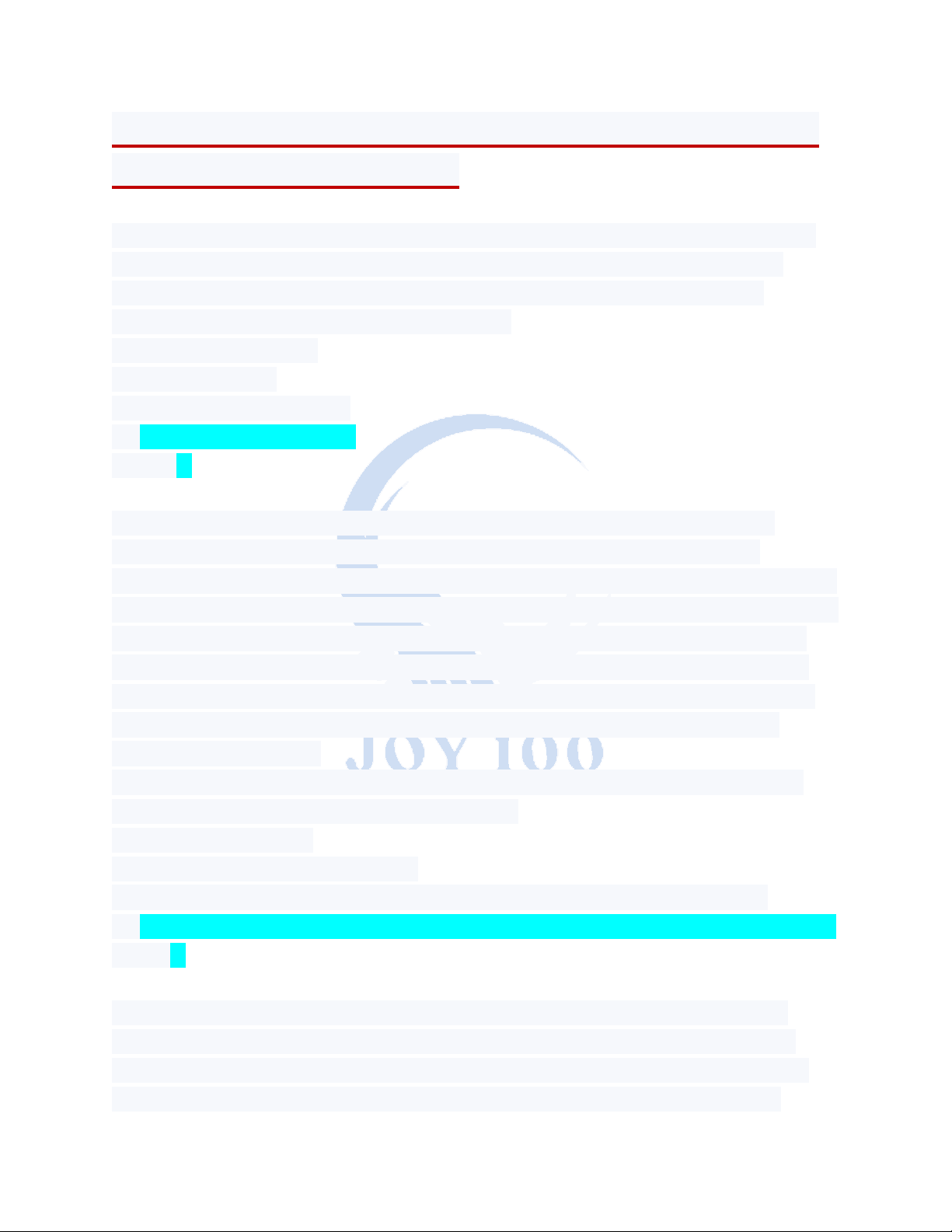
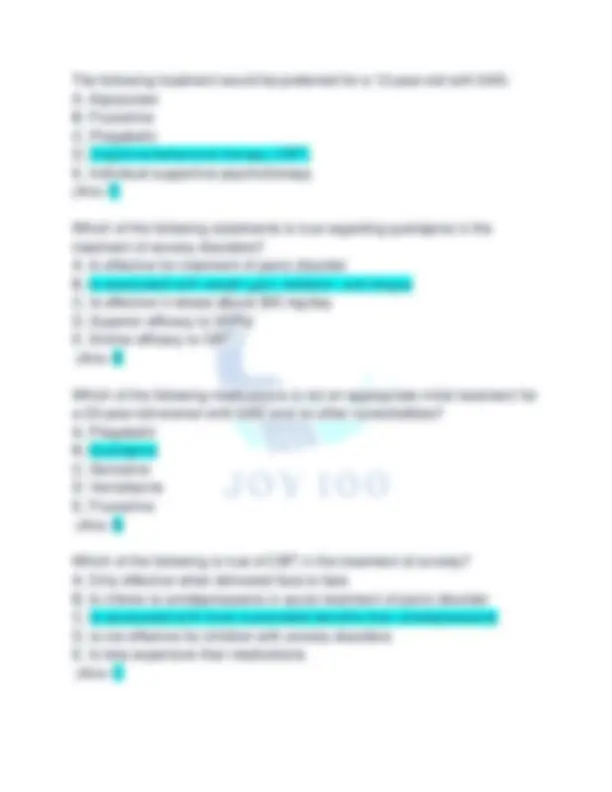
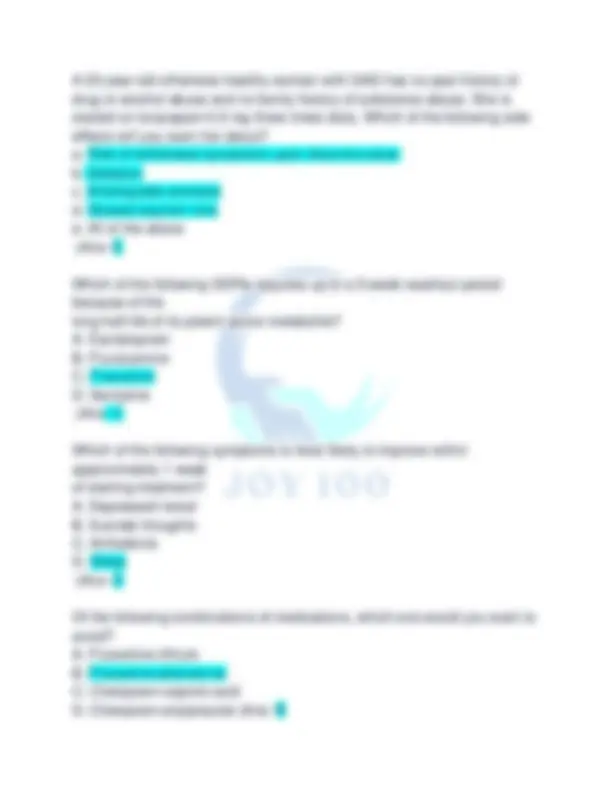
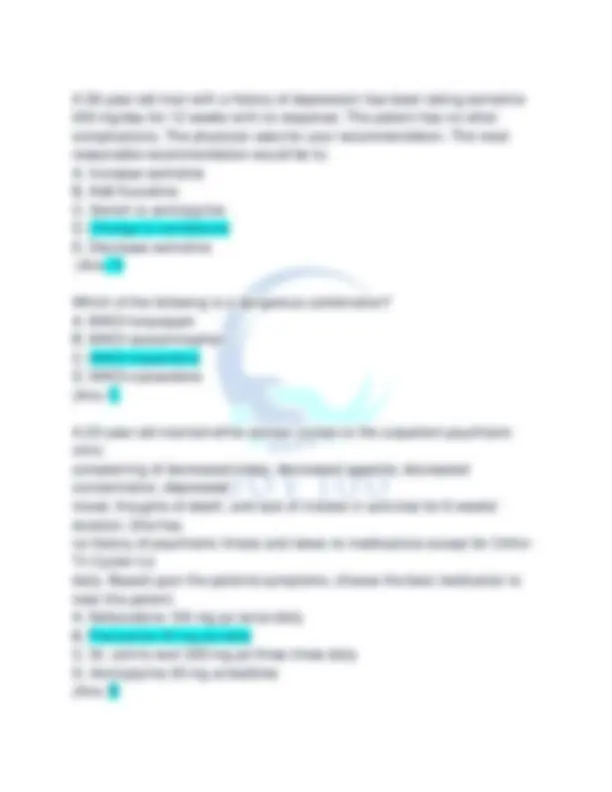
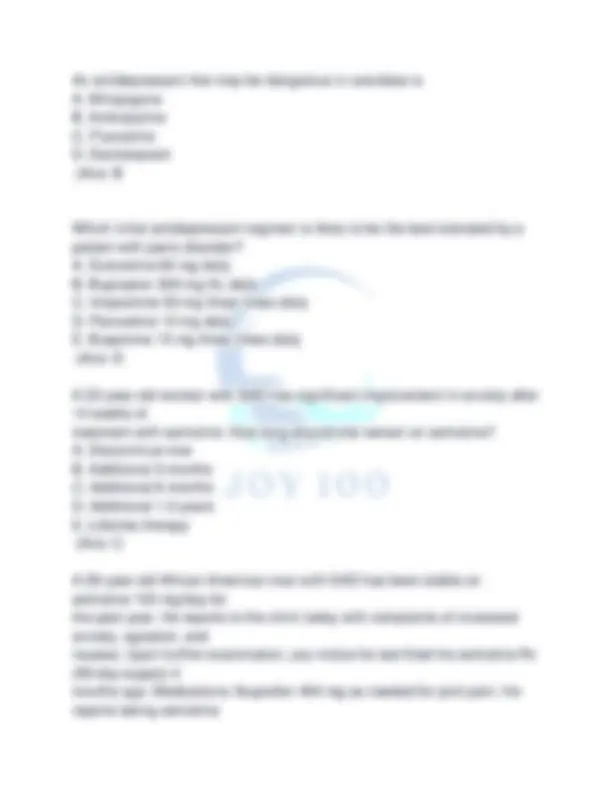
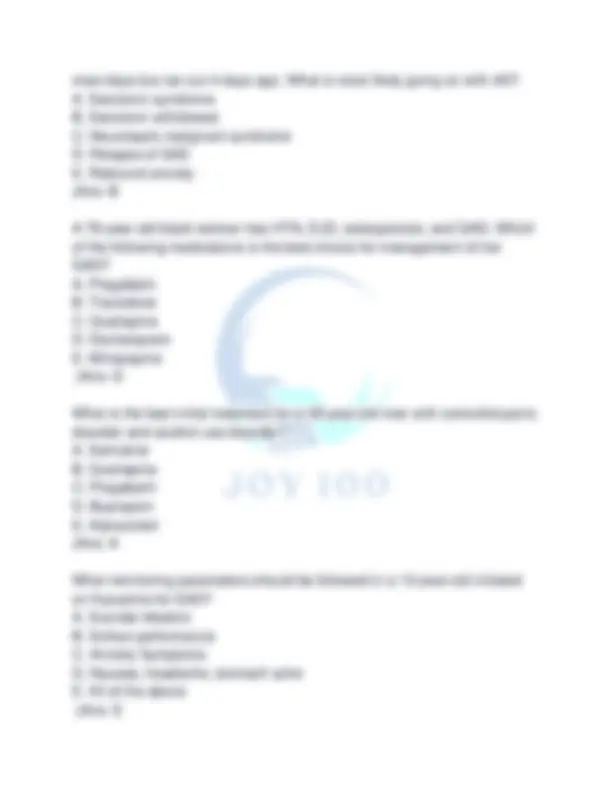


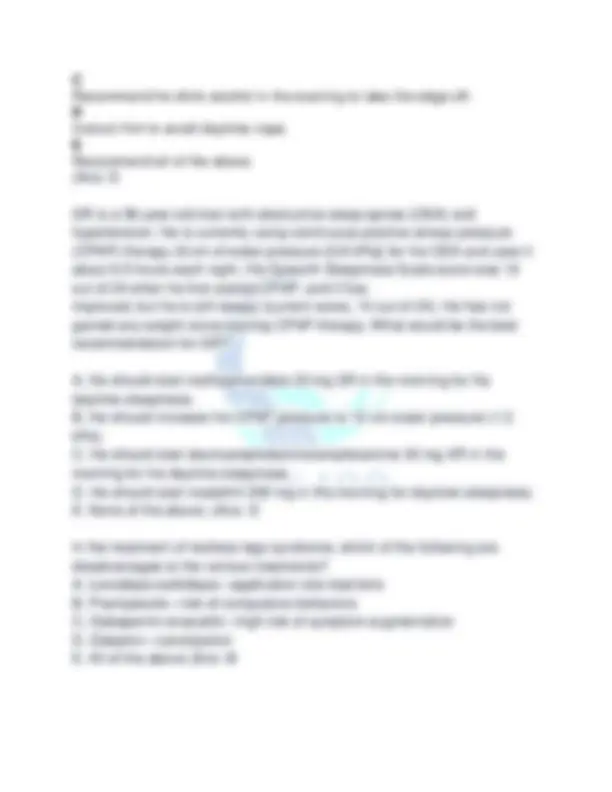
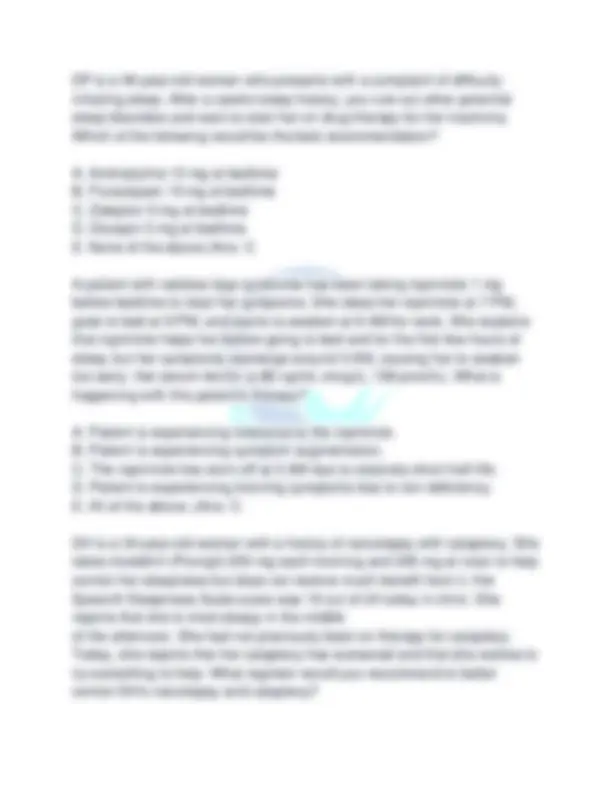


Study with the several resources on Docsity

Earn points by helping other students or get them with a premium plan


Prepare for your exams
Study with the several resources on Docsity

Earn points to download
Earn points by helping other students or get them with a premium plan
Community
Ask the community for help and clear up your study doubts
Discover the best universities in your country according to Docsity users
Free resources
Download our free guides on studying techniques, anxiety management strategies, and thesis advice from Docsity tutors
Various aspects of psychiatric medication management, including the treatment of major depressive disorder, panic disorder, generalized anxiety disorder (gad), and other mental health conditions. It provides guidance on appropriate medication choices, dosing, and management of side effects. The document also discusses the use of cognitive-behavioral therapy (cbt) in the treatment of anxiety disorders and the role of different medication classes, such as antidepressants, benzodiazepines, and antipsychotics, in the management of these conditions. Additionally, it covers topics related to sleep disorders, including insomnia, restless leg syndrome, and narcolepsy, and the appropriate pharmacological interventions for these issues.
Typology: Exams
1 / 16

This page cannot be seen from the preview
Don't miss anything!










A 28-year-old man with a history of depression has been taking sertraline 200 mg daily for 12 weeks with no response. The patient has no other complaints. The physician asks for your recommendation. The most reasonable recommendation would be to: A. Increase sertraline B. Add fluoxetine C. Switch to amitriptyline D. Change to venlafaxine (Ans- D AS is an 18-year-old woman hospitalized for the fourth time for major depressive disorder. On this occasion, AS was admitted for suicidal ideation. Her other symptoms include loss of appetite, insomnia, decreased energy, increased agitation, and anhedonia for the past 2 months. Although she did well her first semester of college, AS "partied: a lot and broke up with a new boyfriend. Two months ago, AS refused to go back to college after the winter holidays. She does not have any other medical problems. AS's mother and grandfather have a history of bipolar illness, and her father has a history of substance abuse. AS's symptoms meet the criteria for major depressive disorder based upon the fact that she has: A. A history of mania B. A history of substance abuse C. Felt suicidal and had four target symptoms for more than 10 days D. Had a loss of pleasure and four target symptoms for more than 2 weeks. (Ans- D A 38-year-old male is diagnosed with major depressive disorder by his general practitioner. His symptoms include depressed mood, insomnia, decreased appetite, and poor concentration. He denies suicidal ideation. The patient remembers that his mother and brother responded well to
venlafaxine in the past, and he would like to try the same medication. Which of the following monitoring parameters would be the most important to follow on this medication? A. Blood pressure B. White blood cell count 7 C. Electrocardiogram D. Potassium levels 8 (Ans- A Which of the following statements regarding panic disorder is true? A. Panic attacks are expected and have an identifiable trigger B. Panic attacks usually peak in intensity in about 1 hour. C. Agoraphobia is always present. D. It is more common in men. E. Panic symptoms are self-limiting in duration. (Ans- E Which of the following substances/medications would not be expected to contribute to panic anxiety? A. Albuterol B. Olanzapine C. Cannabis D. Phenylephrine E. Caffeine (Ans- B Pregabalin is a preferred treatment for a patient with GAD and a history of which of the following? A. Comorbid depression B. Alcohol dependence C. Did not tolerate SSRIs D. Renal impairment E. Nonadherence (Ans- C
A 23-year-old otherwise healthy woman with GAD has no past history of drug or alcohol abuse and no family history of substance abuse. She is started on lorazepam 0.5 mg three times daily. Which of the following side effects will you warn her about? a. Risk of withdrawal symptoms upon discontinuation b. Sedation c. Anterograde amnesia d. Slowed reaction time e. All of the above (Ans- E Which of the following SSRIs requires up to a 5-week washout period because of the long half-life of its potent active metabolite? A. Escitalopram B. Fluvoxamine C. Fluoxetine D. Sertraline (Ans- C Which of the following symptoms is most likely to improve within approximately 1 week of starting treatment? A. Depressed mood B. Suicidal thoughts C. Anhedonia D. Sleep (Ans- D Of the following combinations of medications, which one would you want to avoid? A. Fluoxetine-lithium B. Fluoxetine-phenelzine C. Citalopram-valproic acid D. Citalopram-aripiprazole (Ans- B
A 26-year-old man with a history of depression has been taking sertraline 200 mg/day for 12 weeks with no response. The patient has no other complications. The physician asks for your recommendation. The most reasonable recommendation would be to: A. Increase sertraline B. Add fluoxetine C. Switch to amitriptyline D. Change to venlafaxine E. Decrease sertraline (Ans- D Which of the following is a dangerous combination? A. MAOI-lorazepam B. MAOI-acetaminophen C. MAOI-meperidine D. MAOI-ziprasidone (Ans- C A 23-year-old married white woman comes to the outpatient psychiatric clinic complaining of decreased sleep, decreased appetite, decreased concentration, depressed mood, thoughts of death, and lack of interest in activities for 6 weeks' duration. She has no history of psychiatric illness and takes no medications except for Ortho- Tri Cyclen Lo daily. Based upon the patients symptoms, choose the best medication to treat this patient. A. Nefazodone 100 mg po twice daily B. Paroxetine 20 mg po daily C. St. John's wort 300 mg po three times daily D. Amitriptyline 25 mg at bedtime (Ans- B
Which of the following is a flaw in the monoamine hypothesis of depression? A. Concentrations of neurotransmitters are reduced in the synaptic cleft B. A switch to a different class of antidepressants does not improve response C. Antidepressant response is associated with a therapeutic level of the medication D. Antidepressant effects on neurotransmitters do not temporally correspond to response. (Ans- D A 26-year-old patient with a first episode of depression has been treated with duloxetine 60 mg twice daily for the past 4 months. The patient would like to discontinue treatment. The patient should be told that they need at least _____full months of antidepressant therapy after reaching full remission. A. 3 B. 6 C. 9 D. 12 (Ans- B Which of the side effects of trazodone for the treatment of depression is most frequently observed? A. Hematuria B. Delayed orgasm C. Priapism D. Orthostasis (Ans- D
An antidepressant that may be dangerous in overdose is A. Mirtazapine B. Amitriptyline C. Fluoxetine D. Escitalopram (Ans- B Which initial antidepressant regimen is likely to be the best tolerated by a patient with panic disorder? A. Duloxetine 60 mg daily B. Bupropion 300 mg XL daily C. Imipramine 50 mg three times daily D. Paroxetine 10 mg daily E. Buspirone 15 mg three times daily (Ans- D A 22-year-old woman with SAD has significant improvement in anxiety after 14 weeks of treatment with sertraline. How long should she remain on sertraline? A. Discontinue now B. Additional 3 months C. Additional 6 months D. Additional 1-2 years E. Lifetime therapy (Ans- C A 26-year-old African American man with SAD has been stable on sertraline 100 mg/day for the past year. He reports to the clinic today with complaints of increased anxiety, agitation, and nausea. Upon further examination, you notice he last filled his sertraline Rx (90-day supply) 4 months ago. Medications: Ibuprofen 400 mg as needed for joint pain. He reports taking sertraline
Which of the following GAD patients is most likely to be a CYP 2C19 poor metabolizer and will have an exaggerated response to diazepam 5 mg three times daily with increased sedation and CNS and cognitive side effects? A. 25-year-old white woman B. 25-year-old black woman C. 45-year-old black man D. 45-year-old Asian man E. 45-year-old white man (Ans- D AD is a 58-year-old man who presents to your clinic with the complaint that he "just can't sleep at night." Upon further questioning, he reports that he typically falls asleep without problem but wakes up multiple times throughout the night. Which of the following sleep disorders could AD possibly have? A. Insomnia B. Obstructive sleep apnea C. Narcolepsy D. Restless legs syndrome E. All of the above (Ans- E RS is a 28-year-old man with a history of obsessive-compulsive disorder who reports that he kicks his legs during the night, which wakes him up. He reports that he does not really have any symptoms of restless legs syndrome, but the leg kicking frequently awakens him in the middle of the night and causes him to be sleepy during the daytime. RS has a body mass index of 21 kg/m2 and is normotensive, and his wife says he does not snore or stop breathing during sleep. What would you recommend for RS? A. Temazepam 15 mg at bedtime B. Polysomnography C. Pramipexole 0.5 mg at bedtime D. Multiple sleep latency test
E. Gabapentin 300 mg at bedtime (Ans- A Regarding therapies for the treatment of insomnia all of the following are correct except: A. Sedating antidepressants are commonly used to treat insomnia despite few good studies that document efficacy for insomnia. B. Nonbenzodiazepines (zolpidem, zaleplon, eszopiclone) are generally associated with less rebound insomnia than traditional benzodiazepines. C. Based on efficacy studies, BZDRAs and ramelteon are the drugs of choice for the treatment of insomnia. D. Suvorexant is an orexin receptor antagonist used for insomnia that is novel because it is not a controlled substance. E. All of the above are correct. (Ans- D Which of the following is a consequence of unidentified and untreated sleep disorders? A. Hypertension B. Motor vehicle accidents C. Excessive daytime sleepiness D. Irritability E. All of the above (Ans- E BB is a 48-year-old man with a history of RLS. Over the past year, his RLS has gotten worse, and he has increased the dose of his pramipexole therapy to 1 mg prior to bedtime. His symptoms started appearing earlier in the day, and he had new symptoms in his arms. What strategy should be implemented to manage his symptom augmentation? A. Switch to a shorter-acting dopaminergic agent
JM is a 38-year-old man traveling to Europe on business. He asks you for a recommendation to treat jet lag upon his arrival. Based on the available evidence, which agent would you recommend? A. Valerian B. Diphenhydramine C. Mirtazapine D. Melatonin E. Quazepam (Ans- D A patient presents to the clinic and tells you that he is looking for something to help him fall at night. He reports that he frequently goes to bed and cannot fall asleep for 2 or 3 hours, so he lies in bed and watches television. Upon further questioning, he relays the following information about his sleep and medical history: SH: Retired and married with two grown children. No tobacco use. Does not drink alcohol or caffeine. He exercises at the health club in the mornings. Sleep patterns: Goes to bed on average at 11 PM and awakens with alarm at 6 AM but frequently does not fall asleep until 1 or 2 AM. No awakenings after he is asleep. No reports of limb restlessness. Tired in the daytime and naps for about an hour each afternoon but thinks it is related to inadequate sleep time. What would you recommend to the patient to improve his sleep hygiene? A Instruct him not to exercise; it may contribute to his complaint. B Instruct him to continue watching television in bed; it will help him fall asleep more easily.
Recommend he drink alcohol in the evening to take the edge off. D Instruct him to avoid daytime naps. E Recommend all of the above. (Ans- D GR is a 58-year-old man with obstructive sleep apnea (OSA) and hypertension. He is currently using continuous positive airway pressure (CPAP) therapy (8 cm of water pressure [0.8 kPa]) for his OSA and uses it about 6.5 hours each night. His Epworth Sleepiness Scale score was 19 out of 24 when he first started CPAP, and it has improved, but he is still sleepy (current score, 14 out of 24). He has not gained any weight since starting CPAP therapy. What would be the best recommendation for GR? A. He should start methylphenidate 20 mg SR in the morning for his daytime sleepiness. B. He should increase his CPAP pressure to 12 cm water pressure (1. kPa). C. He should start dextroamphetamine/amphetamine 30 mg XR in the morning for his daytime sleepiness. D. He should start modafinil 200 mg in the morning for daytime sleepiness. E. None of the above. (Ans- D In the treatment of restless legs syndrome, which of the following are disadvantages to the various treatments? A. Levodopa-carbidopa—application site reactions B. Pramipexole—risk of compulsive behaviors C. Gabapentin enacarbil—high risk of symptom augmentation D. Zaleplon—constipation E. All of the above (Ans- B
A. Switch to methylphenidate 20 mg SR in the morning and at noon and add venlafaxine 75 mg/day. B. Increase her modafinil to 400 mg in the morning and 200 mg at noon. C. Keep modafinil dose the same and add venlafaxine 75 mg in the morning. D. Switch to methylphenidate 10 mg taken in the morning. E. Switch to dextroamphetamine 5 mg in the mor (Ans- A VF is a 74-year-old man who is accompanied today in your clinic by his wife. She reports that for the past few months, VF thrashes around in bed violently during the latter half of the night (one to two times per week). He has flown out of bed on occasion and bruised his arm by hitting the wall. When asked about these episodes, he replies that he is usually dreaming about a struggle before he wakes up. What is the best diagnosis and matching appropriate therapy for VF? A. NREM parasomnia—sleep walking—clonazepam B. NREM parasomnia—night terrors—bupropion C. REM parasomnia—REM behavior disorder—clonazepam D. Periodic limb movements of sleep—ropinirole E. Restless legs syndrome—gabapentin (Ans- C